Netflix’s “Midnight Mass”: A Monster with a Message
Despite some flaws, this new installment by Mike Flanagan is well worth a watch.

I’m a horror girl. I grew up on teen slashers. I’m always excited when Netflix releases something new in that genre and they have been going in some interesting directions lately. While I still think “The Haunting of Hill House” is their best attempt at a high quality intellectual horror series to date, “The Haunting of Bly Manor” which came after it was certainly not without its merits and “Midnight Mass” - the newest installment in the genre from the same creator, Mike Flanagan - did not leave me disappointed, either. As I delve into what’s great about it, as well as some of its issues, please beware of spoilers.
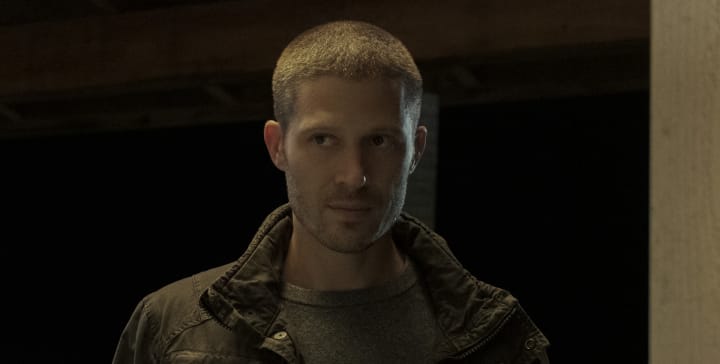
What is “Midnight Mass”?
The story takes place on a small isolated island populated predominantly by fishermen. What seems like our protagonist (although that later becomes more debatable) is a young alcoholic named Riley who has just been released from prison after spending four years there for killing a girl in a car accident while drunk. Plagued by guilt, he returns to the island’s small conservative community where his parents and younger brother live to try and figure out his way forward. Around the same time a young priest, Father Paul, also arrives on the island, claiming to be a temporary replacement for the old Monsignor Pruitt who was due to return from a pilgrimage to the holy lands. While initially apprehensive, the islanders quickly warm up to Father Paul. As they are forced to admit, Monsignor Pruitt was growing rather senile and confused before he left and his leadership of the church wasn’t really up to par.
Riley has developed firmly atheistic views during his time in prison but he is cajoled by his family to attend church, although he still refuses to drink the communion wine. During one particular service the attendants witness what appears to be a miracle - a wheelchair-bound teenage girl regains her ability to walk. From that point on Father Paul’s services become increasingly more popular and the miracles multiply, although not everyone is convinced of their divine origin.
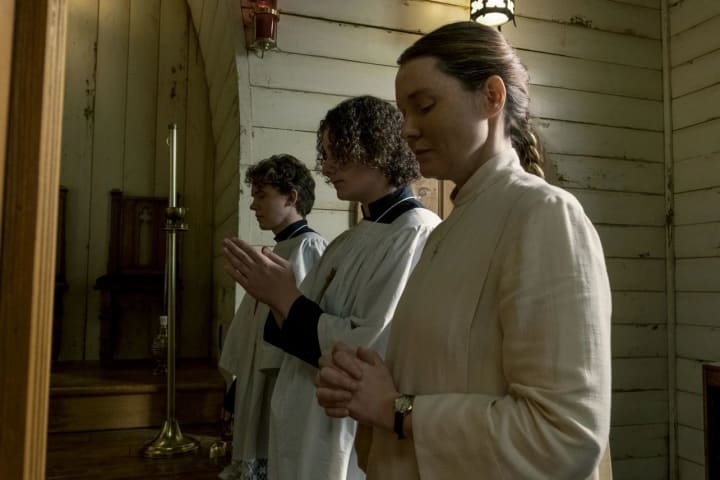
The various subplots and relationships in the series are too many and too complex to easily summarise but the colourful ensemble cast includes (in addition to Riley, his family and Father Paul) the young disabled girl whose spine was injured in a shooting accident, the miserable old drunk who injured her, a Muslim sheriff and his teenage son who have moved to Crockett Island in the hopes of escaping prejudice, a lesbian doctor and her mother who initially suffers from dementia but miraculously recovers, Riley’s old flame Erin who has escaped an abusive relationship and come back to the island to be a single mother to her yet unborn baby, as well as the story’s de facto antagonist - a seemingly very devout woman by the name of Bev Keane who is quite adept at subtly manipulating the other residents and twisting scripture for her own purposes. The portrayals are all excellent and the mystery of what is actually happening is revealed gradually with plenty of clues along the way. Most viewers will probably guess the gist of what is going on relatively early but there is still enough suspense to keep things interesting.
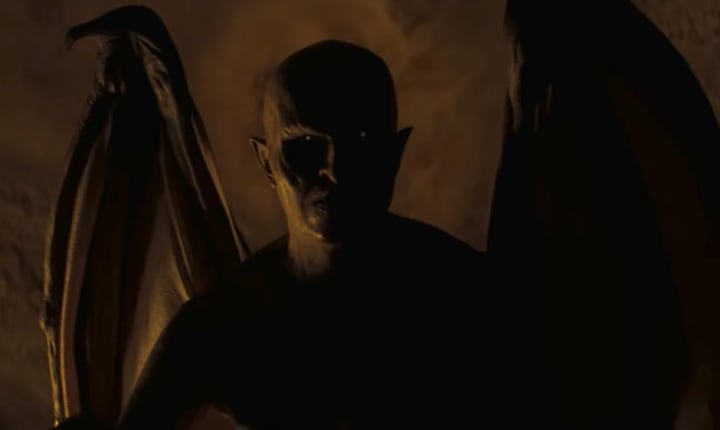
A Fresh Take on a Classic Monster
Spoiler alert - it’s all about vampires. I figured this out pretty quickly but the realisation was somewhat surprising because “Midnight Mass” doesn’t feel much like a vampire series. To be sure, there is the ancient vampire who starts it all by attacking Monsignor Pruitt in Damascus and is subsequently brought by him to the island. That vampire looks like a classic illustration, bat wings and all. The main staples of vampire lore are present, too - becoming a vampire after drinking another vampire’s blood and being burned by sunlight. But, to the show’s credit, the word “vampire” is nowhere to be found in the script. This is clever because this word comes with pop-culture connotations which have become almost comical nowadays. By making sure it’s never uttered even once on screen and waiting until we are well into the series before revealing the nature of the monster, the creators manage to refocus our attention on what is happening and why it’s scary rather than the fact that we’ve seen this creature portrayed so many times before. What’s more, we are never given a definitive answer about whether this vampire is consciously evil or demonic in nature. It appears intelligent but doesn’t speak. It doesn’t reveal its motivation. It’s just there, doing what vampires do - drinking blood and turning people. In many instances it acts much like a wild animal, ambivalent towards the good or evil of its own or anyone else’s actions. The biggest atrocities in the story are committed by humans, the vampire just goes along with them, not seeming to care one way or another.

Another original element at the core of the series is the radically different angle from which the monster is viewed, especially in the context of religion. Father Paul (who is later revealed to be the de-aged Monsignor Pruitt himself) is convinced that he has encountered an angel who has healed his mind and restored his body. In his eyes, all the sinister effects of drinking the vampire’s blood are divine miracles. This take, while I’m sure it must have been done before somewhere, is certainly not common and it’s quite ingenious in how logical and realistic it is. Father Paul’s rationalisations make perfect sense when put together with some Bible passages that seem to support them. The idea of “drinking the blood of Christ” is already present in Catholicism so replacing the communion wine with the “angel’s” blood does not seem that outrageous, especially when its healing properties seem to improve the health of anyone who drinks it. The creature itself is scary to look at but according to the Bible angels are supposed to be terrifying and people who meet them always react with fear. From the point of view of many of the characters, everything aligns perfectly with God’s word.

Is the Series Anti-Religious?
Well… yes, kinda. But not aggressively so?
I would not make any assumptions about the beliefs of the creators but in terms of its messages “Midnight Mass”, despite its fantastical villain, does seem to plant itself very firmly on the side of logic, reason and science over any type of absolute belief. It is far from the first piece of media to show that a religious organisation can become an instrument for evil but most such stories are very careful to separate the specific negatively portrayed church from the idea of religion as a whole. I would argue that, intentionally or not, “Midnight Mass” goes a few steps further and dares to say that religion itself is inherently flawed. While the show clearly strives to be fair to all of its characters, not condemning any of them for having faith and acknowledging its importance in their lives, those among them who are not religious are given a very strong voice. Riley, despite being troubled, does not appear lost or in need of guidance when it comes to his ideas on right and wrong, life and death. In a conversation with Erin about what happens when they die he delivers a very eloquent, science-based speech which does not sound bleak or cynical but on the contrary - it is a hopeful, viable alternative to the idea of God and Heaven. These ideas are later echoed and elaborated on by Erin herself in a truly beautiful inner monologue as she lays dying at the very end of the series. That monologue is possibly my favourite moment in the show, probably because, being an atheist and a woman of science, I can easily agree with every word and find it incredibly reassuring and inspiring, far more so than any Bible verse.

It seems obvious that a series with vampires in it would acknowledge that the supernatural, and by extension the divine, are real. But even that is not made completely clear. While no real scientific explanation for the origin of the vampire or the effects of its blood is offered, the show strongly hints that such an explanation might exist, we just don’t know it. Some of the protagonists treat the situation as if they are dealing with a type of contagious disease. The doctor character does not seem bothered by the fact that she doesn’t have all the answers. She seems firm in her belief that those answers are probably out there, if beyond her reach, and her own ignorance is not proof of magic. She is willing to believe her eyes and act according to what is going on, she does not dismiss what she is seeing simply because she can’t explain it, but at the same time she is not ready to jump to conclusions about the reasons behind every strange phenomenon she witnesses. This is a rarely good portrayal of a person of science in a fantastical setting. All too often the sceptics in a cast of characters are shown to outright deny the very obvious thing that is happening simply because they disagree with people’s explanations for what it is. But that’s not how real scientists - or smart people - act. An intelligent sceptic being chased by what appears to be a murderous ghost will still run, even if they don’t believe in ghosts. They will just try to work out what the thing actually is later, when they are safe.

Another point in favour of those with more secular views is Father Paul/Monsignor Pruitt’s personal arc. His motivation, we learn towards the end, really had much less to do with religion. It was more about a perfectly human love affair from his youth which resulted in an illegitimate child. It is ultimately this love that is presented as his redemption and not his belief in a higher power.
What Are Some of the Show’s Shortcomings?
There aren’t too many and they are mostly forgivable.
Riley’s premature exit from the series is very abrupt. I think I understand what the writers were going for - it is a subversion of expectations, the person we have come to assume is the protagonist turns out not to be the ultimate hero of the story. But even so, Riley as a character feels just a touch too irrelevant. He seems to be there as a counterpoint to all the religious folk on the island but this conflict never really reaches a satisfying conclusion. His backstory also seems to play little part in the plot overall. He is haunted by visions of the girl he killed but, much like the dead fiance in “The Haunting of Bly Manor”, this little element doesn’t really go anywhere beyond providing a cool spooky visual. (I did actually really like how the silent ghost had become such a constant presence in his life that he regarded it almost casually and, on one occasion, asked it about its day.)
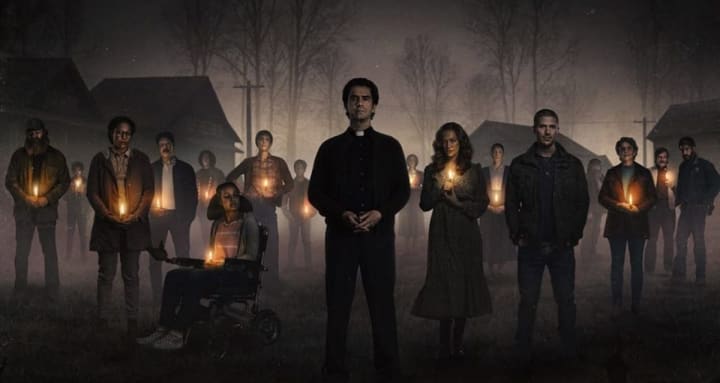
In addition, the way the entire story is resolved at the end represents a pretty substantial plot hole. After all the buildings on the island are burned down, the now vampiryfied residents are reduced to ash come sunrise. This begs far too many questions. We are shown that it is only direct sunlight that affects them - curtains and shade are enough to keep them safe. So why do they all die? Okay, we know that some of them have simply decided it is the right thing to do - they gather together and sing one final hymn as the sun rises and obliterates them mid-note. It’s a beautiful scene. But I am finding it hard to believe that every single resident was this self-sacrificial. In fact, we know that’s not the case. Bev, selfish until the end, clearly has no desire to die. As the sun is almost upon her, we see her starting to frantically dig a hole in the sand seconds before she burns to ash. Honestly? If she’d started a few minutes earlier she would have probably been fine! I was very much reminded of the scene from “Interview with the Vampire” where Claudia and her new friend are killed by the “bad vampires” by being locked in a well or something of that sort. Upon watching the movie, some clever scientific minds figured out that their deaths were geographically extremely improbable - in that part of the world the sun could have never shone so directly above where they were as to illuminate the entire hole without any shade, ergo they would have been fine. Similarly, there would be some shade somewhere on this island for people to hide in. There would be some debris after the fires that they could crawl under. Even if they just took their clothes off and created some sort of flimsy shelter, that would have still probably worked.
But, as I said, such things are ultimately forgivable. This is not a slasher franchise so the vampires must die, there must be a definitive ending. In the end, the heart of the series lies less in its plot and more in its messages, and those messages do find their way to the audience.
In Conclusion
While I don’t think “Midnight Mass” is particularly scary, it is certainly engaging, well-made and valuable in what it wants to tell us. A little research reveals that this was a passion project for Mike Flanagan and it shows - the series has a lot of heart. He tried to pitch it unsuccessfully several times but kept the project alive over the years and I am very glad it finally got made. Overall, I thought it was executed better than “The Haunting of Bly Manor” which is a hopeful sign that the quality of these elaborate horror series is not declining but perhaps even improving and we can expect more excellent installments in the future.
About the Creator
Yana Aleks
Fiction writer, reviewer and an incurable chatterbox.


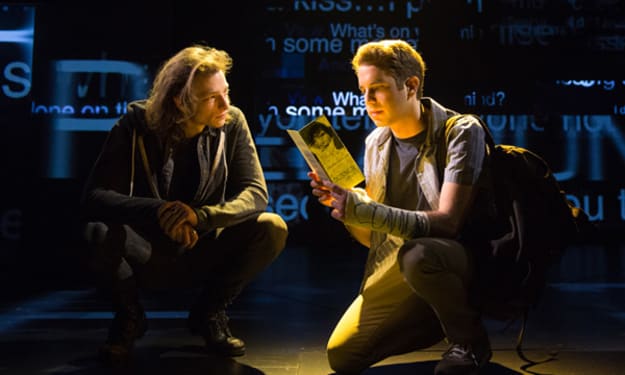



Comments
There are no comments for this story
Be the first to respond and start the conversation.